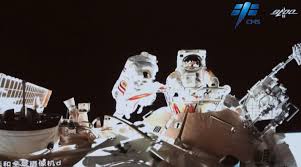Dressed in China’s new-generation extravehicular mobility units (EMUs), Chinese astronauts Zhai Zhigang and Wang Yaping, both on the country’s Shenzhou-13 spaceflight mission, lately stepped out of the Tianhe core module of the Tiangong space station of China for extravehicular activities (EVAs).
Wang Yaping, who completed her first spacewalk in the new-generation homemade spacesuit named “Feitian”, became China’s first female astronaut to conduct EVAs and attracted wide attention.
Conducting EVAs is an essential part of astronauts’ work in space, as the maintenance and upgrading of space station depends highly on astronauts’ EVAs.
Extravehicular spacesuits, which weigh as much as over 100 kilograms, are undoubtedly “protective armor” for astronauts. They can guarantee astronauts’ safety and enable them to complete EVAs smoothly.
The environment of outer space is very complex. Harsh environmental factors such as vacuum, high and low temperatures, solar radiation and micro-meteors pose huge risks to astronauts.
While conducting EVAs, astronauts are faced with a space environment with an orbital altitude of 300 to 450 kilometers, temperature variations between 120 and minus 120 degrees Celsius every ninety minutes, as well as space debris and radiation.
To ensure that astronauts can maintain normal life activities and work outside the spacecraft in such an environment, the specially-designed extravehicular spacesuits have to provide safe and effective protection from the environment as well as environmental control and life support in confined space, functioning as a human-shaped spaceship.
Materials and techniques for making EMUs must reach unimaginably high standards as they need to withstand the brutal environment of the outer space while guaranteeing that astronauts can perform extravehicular operations flexibly.
On Sept. 27, 2008, Zhai completed his first EVA wearing the first generation of China’s self-developed Feitian extravehicular spacesuits, which symbolized that China became the third country in the world to independently master the technologies for EVAs.
The second generation of Feitian extravehicular spacesuits, the ones Zhai and Wang wore for the Shenzhou-13 mission, has been upgraded according to the needs of astronauts’ EVAs in the construction stage of the country’s space station.
Compared with the first version, the new-generation extravehicular spacesuits have new structure, longer service life and greater comfortability, thus becoming safer, more durable and reliable and showing stronger flexibility, testability and maintainability.
China’s continuously increasing capabilities in the research and development (R&D) of EMUs serve as vivid demonstrations of the country’s firm steps in advancing its aerospace cause.
As the “lifejackets” of astronauts, the valuable extravehicular spacesuits require complex and precise techniques as well as meticulous R&D and making.
At present, spacesuits are carefully stitched by hand, whether in China and in other countries. It takes over 130 hours to finish the upper limb restraint layer of an intravehicular spacesuit, more than 260 hours to make the lower extremity restraint layer of an EMU, and nearly four months to assemble an extravehicular spacesuit.
The dimensional tolerance during the sewing process cannot exceed one millimeter, and even a single particle of dust may cause a catastrophe, which demands both craft and patience of spacesuit researchers.
Thanks to its aerospace R&D team that can always surmount difficulties and make breakthroughs, China’s self-developed EMUs have been continuously improved to guarantee astronauts’ safety in their exploration of the outer space.
From the Chang’e lunar missions to China’s first Mars mission, from Chinese astronauts’ entering the country’s own space station for the first time to the launch of the country’s first solar exploration satellite Xihe, China’s steadier and bigger strides in exploring further into space have mirrored the country’s continuous advances in aerospace technology. It is believed that the Chinese people will achieve even greater results in space exploration in the future.



